Poignant, funny, and devoid of artifice, the film, streaming on Apple TV+ from August 13, realistically portrays a family with deaf parents through a true-to-life cast
By JORDAN HOFFMAN
12 August 2021, 5:06 am
The Times of Israel
NEW YORK — A coda, in musical terms, represents the concluding passage of a movement. In the life of a young adult, it could, say, be an appropriate way to describe graduating from high school. But CODA is also an acronym for “child of deaf adult.” I was not present when writer-director Sian Heder had the eureka moment for the title of her new film, but I suspect she was very happy.
Ruby (Emilia Jones) is a child of deaf adults who is contemplating leaving home for college. What’s more, she wants to pursue a career in music, as she is a naturally gifted singer. “Oh, if I were blind, would you want to be a painter?” her mother (Marlee Matlin) half-jokes when she learns about Ruby’s developing hobby.
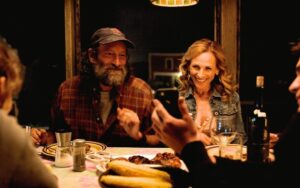 Media: Emilia Jones and Troy Kotsur in ‘CODA.’ (Courtesy Apple TV+)
Media: Emilia Jones and Troy Kotsur in ‘CODA.’ (Courtesy Apple TV+)
Matlin, the Jewish-American actress born and raised outside of Chicago, is the only Academy Award-winning deaf actress, for her landmark performance opposite William Hurt in the 1986 romantic drama “Children of a Lesser God.” (If you have not watched it in 35 years, dig it up again; it’s even better than you remember.) Since that debut, Matlin has worked consistently — most notably on shows like “Pickett Fences,” “The West Wing,” “The L Word,” plus memorable turns on “Seinfeld” and “Dancing With The Stars.”
In “CODA,” a loose adaptation of a French movie with a similar plot but very different vibe, Matlin plays the lead character’s caring mother. As her daughter tries to figure out her future and her place, her husband and son (deaf actors Troy Kotsur and Daniel Durant) are struggling to keep their family fishing company afloat. (The film is set in the very photogenic Gloucester, Massachusetts.) Matlin is not the star of the movie, but her character is the glue of the family.
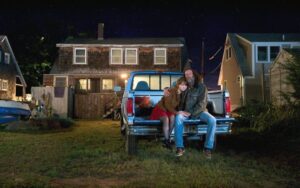 It should be emphasized, it’s not that Ruby’s parents frown on music; it’s just that it’s something that has little impact on their lives. This is key to what makes “CODA” such a fascinating movie: watching the interplay between hearing and deaf cultures.
It should be emphasized, it’s not that Ruby’s parents frown on music; it’s just that it’s something that has little impact on their lives. This is key to what makes “CODA” such a fascinating movie: watching the interplay between hearing and deaf cultures.
Media: Emilia Jones and Troy Kotsur in ‘CODA.’ (Courtesy Apple TV+)
It’s rare that a movie plunges you this deeply into a unique culture but still comes across as “real.” The characters are not physical manifestations of political or social manifestos, they are just human beings. The film is also warm, touching, and very funny. (I mean, on the face of it, it’s comedy: The girl with the deaf family wants to sing, it’s okay to laugh at that!)
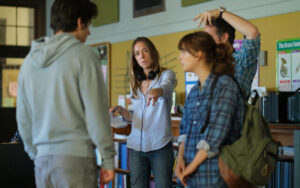 Though this January’s Sundance Film Festival was held virtually, “CODA” was still a tremendous success, selling to Apple for a record $25 million. It will be available on August 13 on Apple TV+, a service you might have free access to without even realizing if you bought an Apple computer recently.
Though this January’s Sundance Film Festival was held virtually, “CODA” was still a tremendous success, selling to Apple for a record $25 million. It will be available on August 13 on Apple TV+, a service you might have free access to without even realizing if you bought an Apple computer recently.
Media: Siân Heder, center, directs Emilia Jones and Ferdia Walsh-Peelo in ‘CODA.’ (Courtesy Apple TV+)
I had the good fortune to speak to Matlin through her interpreter via Zoom recently. Below is a transcript of our conversation, edited for clarity.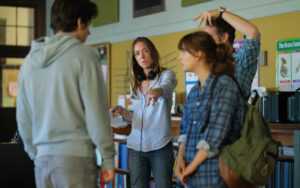
Media: Siân Heder, center, directs Emilia Jones and Ferdia Walsh-Peelo in ‘CODA.’ (Courtesy Apple TV+)
You have been consistently busy for 35 years, but I would imagine this is the type of project that you have been dreaming about for a long time.
Absolutely. It’s a dream project, authentic in its storytelling, and entertaining at the same time, with real-life deaf actors in deaf parts, carrying the film as leads. And a lot of the things that happen in this film happen in real life. It’s not “based on a true story,” but we’re seeing people with working-class careers who live in deaf cultures, and people who are CODAs. I’m a mom of four CODAs, so for them to see a movie like this lets them see their perspective on screen.
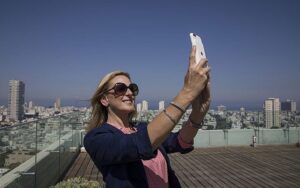 We [in the community] share similar characteristics, but we’re not all the same. In this film we have a mother-daughter [relationship], a mother-husband, a husband-daughter, etc. I could not have asked for anything better, from cast to crew to director, the whole package.
We [in the community] share similar characteristics, but we’re not all the same. In this film we have a mother-daughter [relationship], a mother-husband, a husband-daughter, etc. I could not have asked for anything better, from cast to crew to director, the whole package.
Media: American Oscar winning actress Marlee Matlin takes a selfie at the rooftop of Tel Aviv municipality Monday, June 19, 2017. Matlin was in Israel to receive the prestigious Morton E. Ruderman Award for her lifelong activism for people with disabilities. (AP Photo/Tsafrir Abayov)
You mention the director; I was surprised that she did not know American Sign Language beforehand and that the lead actress also learned it for the movie. Filmmaking is “faking it for the camera” but how much does it help when co-workers are putting in that extra mile?
[A great movie] takes a great director and great actors to do their homework. Sian did her homework. She delved into deaf culture, she asked questions and brought in people who know our culture, and she learned the language. That allowed her to create, develop, and work with us in an authentic fashion. It was a perfect collaboration.
I also noticed, watching the closing credits: Woman writer-director (Sian Heder), woman cinematographer (Paula Huidobro), woman production designer (Diane Lederman). This is somewhat rare.
I didn’t even know until we got on set. I get there and, “Oh you’re the director of photography? Great!” And more: Set designer, makeup department, drivers on the crew. Both of our [on-set] ASL masters were women. It was a beautiful package.
I read that after you had signed on to the project some of the early financial investors did not want the other family members to be played by deaf actors, and you had to put your foot down. It’s hard to think of this movie without Troy Kotsur, specifically.
When I first read the script my initial thought was that this belongs to Troy. Frank is Troy, Troy is Frank. Immediately.
Then I heard they were somewhat hesitant and wanted a name for box office appeal. “Oh, gosh, we don’t know if we want a deaf actor.”
I was mortified. I said, “How dare you? How dare you, without even knowing him?” So, yeah, I said if you don’t hire a deaf actor, I’m out. And I hoped that wasn’t going to happen because I wanted to be in this film! But I wasn’t about to let those people take away that role from someone who was deaf. It’s so precious and real, so authentic, so accessible and inclusive. It’s our time. It’s our work. It’s our culture. Don’t you dare take it away from us. And I’m glad that they didn’t.
[Note: following the interview with Matlin, a producer of “CODA” who was listening in on the conversation without my knowledge emailed me to say that “from the start we decided to hire deaf actors,” and that the production exclusively screen-tested deaf actors. Matlin likewise had a different spin on the events in a January interview with the Los Angeles Times.]
With film acting, the camera makes every subtle facial expression seem huge, and to a degree that’s what sign language does. I feel like deaf actors almost have a leg-up in being great film actors.
That’s who we are. We are culturally expressive. We are identified that way.
Listen, there are roles that fit a particular actor who is hearing, and it makes sense. But for hearing actors to play deaf roles, it doesn’t cut it anymore. You’re not going to get the real thing. You have no idea what it’s like to be deaf.
I played a hearing character two different times. One was for a movie where the character had a mental health issue, and she didn’t speak like a hearing person. It was a challenge for me to tone it down. Would I do that again? I don’t know. I don’t identify with hearing characters.
On “Quantico” I played a hearing character who became deaf after a bomb blast. That was interesting, because I was somebody who went back and forth between hearing worlds and deaf worlds. It talked about how some hearing people don’t make eye contact, that their body language is completely different. So I studied hearing people for this role, and I used it for that character in a short flashback scene.
But sign language is just perfect for the screen, and you could certainly imagine scenarios where deaf actors are used.
Speaking of other roles, I went back and watched “Children of a Lesser God,” which I have not seen in many years. There are many connections one can make between the two films. For starters, both up in the northeast, surrounded by water, right? It got me thinking about where your character Sarah would be 35 years later. Maybe she stayed with the teacher for a little while, who knows, but this could be her possible future? Do you see it that way? Do you have an idea of what she’s up to these days?
I imagine that Sarah could be a very different person. Maybe she’s grown up, maybe she has a family, maybe she has kids. She’s definitely not with James Leeds [William Hurt’s character] any longer. But… perhaps we can do a later interview on another project that has a connection to that idea. I’m going to leave that as is, and won’t say anything further.
Not sure if you saw this, but in the Israeli Knesset, a woman was just sworn in as the first deaf member of Parliament.
Yes! Shirly, right?
Shirly Pinto, yes. there have been people with some disabilities in American government, but not this step. You think it’s something that might happen any time soon?
It’d be nice! I know several people who would be perfect to become president of the United States. Or senators, or anything.
There are so many activists, attorneys, people fighting for people’s rights. For example, Howard Rosenblum, who runs the National Association for the Deaf. This, by the way, is the oldest civil rights organization in the United States. Throughout the country, and in Washington, DC, there are a lot of deaf people who work with the White House, but they are not necessarily people we see or know. But I think it’s time we do see them, and do know them.
Were you upset you didn’t get a chance to ride the fishing boat when shooting this movie?
I prayed, the entire time reading this script, that my character would not have to be hard at work on the fishing boat. My prayers were answered. I am not one who gets up at 2 a.m. to shoot scenes on that fishing boat. No offense to those actors! I’ve gained tremendous respect for people who work in real life in the fishing industry. Because I love to eat fish, and they are the ones who go out and get it!
They are very proud, the Gloucester fishermen. And were some of the most wonderful, beautiful people I’ve ever met. They were very helpful to us, and taught the rest of the cast how to fish. I only had to deal with dead fish in the scene where we were setting up the business and — ugh. I think that was enough.
I could probably look this up on YouTube, but it would mean a lot more coming from you: How do you sign “oy vey”?
That… is a good question.
There is deaf sign language in Yiddish or in Hebrew. I don’t know it, because sign language is not international. So I’m not sure. I would spell it out. We’d finger-spell each letter like this [signs letters].
Aha! This leads to a philosophical question I’ve never considered before. A lot of times American Jews, particularly when talking with other Jews, might sometimes lean into the Jewish accent on certain phrases. To “Jew it up” a little. Is there a way in sign language for Jews to play up that cultural aspect to other Jews?
No [laughing], and that’s not something I would do. But I will tell you that I am a very proud Jew, I was raised Jewish, I was bat mitzvahed, and I visited Israel a few years ago and found it very beautiful, with beautiful people. And great food.
Source: www.timesofisrael.com/deaf-actress-and-activist-marlee-matlin-on-landing-her-dream-role-in-coda/





